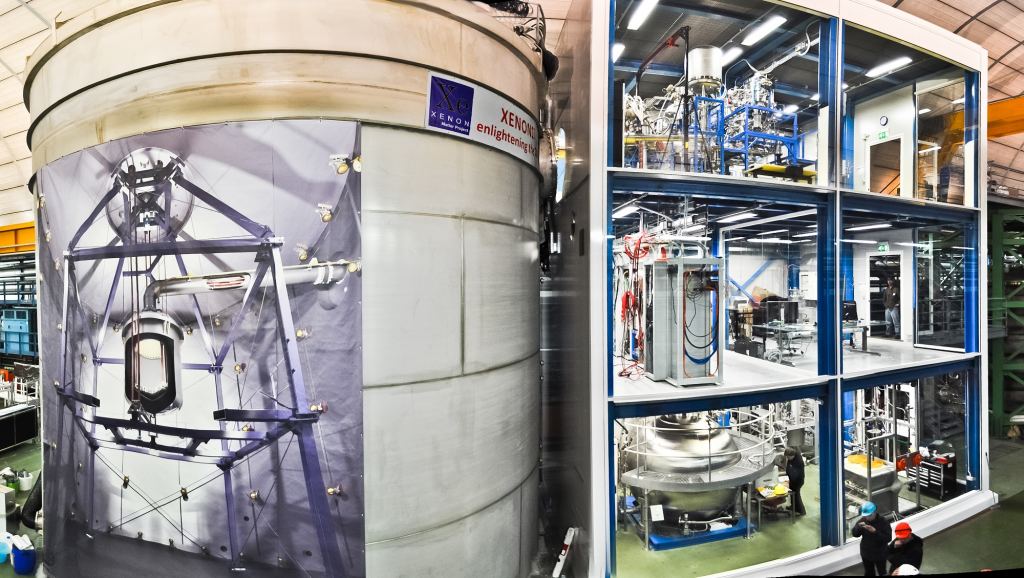Since the 1960s, scientists have theorized that the Universe is filled with a mysterious, invisible mass. Known as “dark matter“, this mass is estimated to make up roughly 85% of the matter in the Universe and a quarter of its energy density. While this mass has been indirectly observed and studied, all attempts at determining its true nature have so far failed.
To address this, multiple experiments are being carried out that rely on immensely sophisticated instruments. One of these, called XENON, recently observed a process that had previously avoided multiple attempts at detection. These results could help scientists to improve their understanding of neutrinos, which some scientists believe is what dark matter is made up of.
The results (XENON1T) appeared as part of a study that was recently published in the journal Nature. XENON is a joint experimental project of about 160 scientists from Europe, the US and the Middle East. It is currently led by Prof. Elena Aprile from Columbia University and operated by the Gran Sasso National Laboratory (LNGS) in Italy.

Like other dark matter experiments, it aims to detect the candidate dark matter particles known as weakly interacting massive particles (WIMPS). For this purpose, the facility is located deep underground so as to avoid interference from other neutrino sources (which include the Solar neutrinos created regularly by our Sun and cosmic neutrinos).
In the case of the XENON experiment, this involves observing a chamber filled with liquid Xenon-124 for signs of particle interactions. These signs would provide the first-ever direct experimental evidence of dark matter candidate particles. And while their first set of results did not confirm the existence of dark matter, it did observe the decay of Xenon-124 atomic nuclei for the first time.
For a number of reasons, this was an immense accomplishment. Aside from being a historic first, the half-life measured for Xenon-124 is about one trillion times longer than the age of the Universe itself (13.8 billion years). This makes the radioactive decay they observed – the so-called double electron capture of Xenon-124 – the rarest process ever observed in a detector.
As Prof. Christian Weinheimer – a from the University of Münster, whose group led the study – explained in a XENON press release:
“The fact that we managed to observe this process directly demonstrates how powerful our detection method actually is – also for signals which are not from dark matter.”
To break this process down, an atom of Xenon-124 is made up of 54 protons and 70 neutrons which are surrounded by atomic shells with 54 electrons. In the process known as double electron capture, two protons in the nucleus simultaneously “catch” two electrons from the innermost shell, transform them into two neutrons, and spit out two neutrinos.
The other electrons then reorganize themselves to fill the gap created in the innermost shell while energy is released in the form of X-rays and what are called “Auger electrons”. However, these signals are very hard to detect since the process is very rare and is hidden by the natural radioactivity. Nevertheless, the XENON collaboration managed to do just thanks to a year’s worth of observations with their instruments.
The X-rays emitted as a result of the double electron capture produced a light signal in the liquid xenon as well as free electrons. These electrons then moved towards the gas-filled upper part of the detector where they produced a second light signal, and the time difference between the two happened to correspond to the time it takes the electrons to reach the top of the detector.
The science team used this interval and the chamber’s sensors to reconstruct the position of the double electron capture while the signal strength was used to measure how much energy was released. This provided scientists with the means to determine the incredibly long half-life of xenon, which they calculated to 1.8×10²² years.

These results effectively demonstrate the XENON detectors ability to detect rare processes while rejecting background signals. The new results could also allow for further investigations into neutrinos, which are the lightest of all elementary particles and are still not fully understood. These include the mass of the neutrino, which is not yet well-constrained.
As Christian
“It proves that this XENON detector technology we use for dark matter is much more versatile. We get all these cool analyses… for free after having built an experiment sensitive enough to hunt for dark matter.”
The XENON1T observation run collected data between 2016 until December 2018, at which point it was shut off to make upgrades. Once those are complete, the science team will begin conducting the next phase of observations. Known as “XENONnT”, this phase will feature an active detector mass three times larger than the first experiment.
Together with upgrades designed to reduce background interference, the detector will have a sensitivity level several orders of magnitude higher. At this point, we can expect that the experiment will shine an even brighter light on the dark areas of the Universe.

